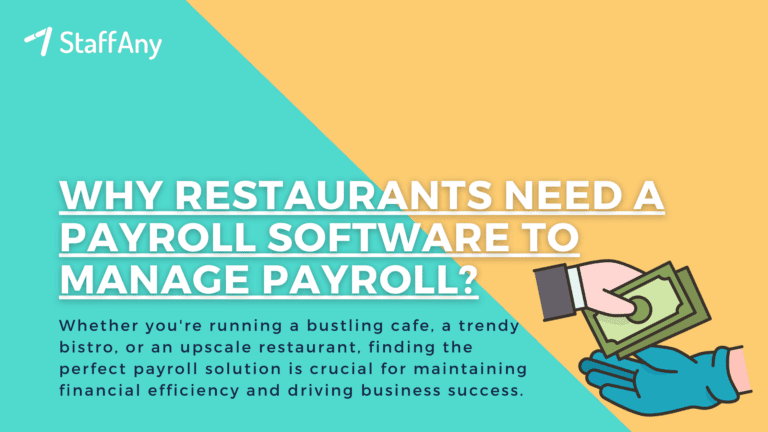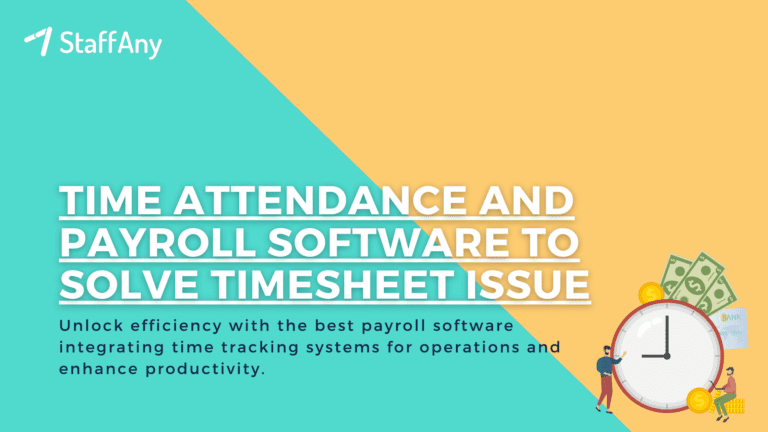In the fast-paced world of the hospitality industry such as restaurants, providing adequate restaurant staff training programs is crucial for boosting productivity and ensuring the success of the establishment. A well-trained staff not only delivers excellent customer service but also contributes to operational efficiency and profitability.
In this article, we will explore the importance of staff training and present eight effective training programs to enhance the skills and performance of restaurant staff. Let’s find out below!
Why is It Important to Provide Training for the Staff?

In any restaurant business, success and smooth operation heavily rely on the skills and knowledge of its staff. Providing training programs for restaurant staff is crucial to enhance their productivity and ensure consistent service excellence. Here are five key reasons why training restaurant employees matters.
1. Improve Customer Service
Well-trained restaurant employees can deliver exceptional customer service, which is vital for customer satisfaction and repeat business. Proper training programs equip staff with the necessary skills to handle customer inquiries, resolve complaints effectively, and provide personalised service.
By focusing on customer service training, restaurant staff can create positive dining experiences that leave a lasting impression on patrons.
2. Enhance Efficiency and Productivity
Efficiency and productivity are critical factors in the fast-paced restaurant industry. Restaurant training programs help staff members develop essential skills, such as time management, multitasking, and prioritisation.
By optimising these skills, restaurant staff can handle their tasks more efficiently, reducing wait times, and increasing overall productivity.
3. Ensure Consistency in Standards
Consistency is key to establishing a reputable brand in the restaurant industry. Training programs play a vital role in setting and maintaining consistent standards across all staff members.
By providing training on standard operating procedures, hygiene practices, and quality control, restaurants can ensure that every customer receives the same level of service and experience, regardless of the staff member serving them.
4. Boost Employee Morale and Satisfaction
Investing in training programs shows that restaurant owners value their staff and their professional growth. The training process would boost employee morale and job satisfaction, leading to higher retention rates and a more motivated workforce.
When staff members feel valued and equipped with the necessary skills to succeed, they are more likely to perform at their best and contribute to a positive work environment.
5. Reduce Employee Turnover
Employee turnover is a significant challenge in the restaurant industry, costing time and resources to recruit and train new staff members. By providing comprehensive training sessions, restaurant owners can reduce turnover rates by fostering a sense of loyalty and commitment among employees.
When staff members are well-trained and supported, they are more likely to stay with the restaurant, reducing recruitment and training costs in the long run.
Read more: 11 Effective Restaurant Risk Management Strategies
Training Program for Restaurant Staff to Boost Productivity
Implementing an effective training program for restaurant staff is crucial for maximising productivity and ensuring consistent performance. Here are eight training programs that can help boost the productivity of your restaurant staff:
1. Food Safety Training
Ensuring food safety and maintaining proper hygiene practices is of utmost importance in the restaurant industry. Training programs on food safety and hygiene educate staff members on proper handling, storage, and preparation techniques.
By equipping employees with the knowledge and skills to maintain high food safety standards, the risk of foodborne illnesses and customer complaints can be minimised.
2. Customer Service Training
Customer service is a fundamental aspect of the restaurant experience. Providing customer service training to restaurant staff helps them develop skills in communication, conflict resolution, and attentive service.
By focusing on building rapport with customers and addressing their needs, restaurant staff can create positive dining experiences and foster customer loyalty.
3. Menu Knowledge and Upselling Training
An in-depth understanding of the menu is essential for restaurant staff to provide accurate and enticing recommendations to customers. Training programs that focus on menu knowledge and upselling techniques enable staff members to showcase the restaurant’s offerings effectively.
By mastering upselling skills, staff members can increase revenue by promoting additional items or suggesting upgrades to customers.
4. POS System and Order Taking Training
Efficiently processing customer orders and accurately using the restaurant’s POS system are vital for smooth operations. Training programs that cover the operation of the POS system and order taking processes ensure that staff members can handle transactions swiftly and minimise errors.
This helps to streamline the dining experience and improve overall efficiency.
Read more: Restaurant Management Plan: Benefits & Development
5. Teamwork and Communication Training
Collaboration and effective communication are essential for a cohesive and efficient restaurant team. Training programs focused on teamwork and communication equip staff members with skills to work together harmoniously, delegate tasks, and communicate effectively in a fast-paced environment.
By fostering strong teamwork, restaurant staff can better support one another and ensure smooth service delivery.
6. Conflict Resolution and Dealing with Difficult Customers
Dealing with challenging situations and difficult customers is an inevitable part of working in the restaurant industry. Training programs that address conflict resolution and provide strategies for handling difficult customers can empower staff members to defuse tense situations and maintain professionalism.
By equipping employees with these skills, the overall dining experience can be improved, even in challenging circumstances.
7. Cross-Training Opportunities
Cross-training provides staff members with the opportunity to learn multiple roles within the restaurant. This not only enhances their skill set but also ensures flexibility in staffing.
By implementing cross-training programs, restaurant owners can mitigate the impact of unexpected absences, increase staff members’ job satisfaction, and optimise productivity.
8. Ongoing Professional Development
To stay competitive and continuously improve, ongoing professional development is crucial for restaurant staff. Encouraging staff members to attend workshops, industry conferences, and seminars enables them to stay updated on industry trends and best practices.
Ongoing training and development programs demonstrate the restaurant’s commitment to excellence and provide staff members with opportunities to enhance their skills and knowledge.
Read more: Understanding Manpower Planning and Its Importance in F&B
Effective Training Methods and Tools
There are various training tools and methods that can be employed in restaurant service training to enhance learning, engagement, and skill development.
Moreover, restaurant service training requires a proper employee handbook and a formal onboarding procedure. Once you complete all the paperwork, you will be ready to welcome the new employee properly into work.
These tools cater to different learning styles and preferences. Here are some common training tools used in restaurant staff training:
1. Hands-On Training and Shadowing
-Practical, on-the-job training where new staff work alongside experienced employees to learn tasks and procedures.
-Shadowing allows trainees to observe experienced staff members, ask questions, and gain real-world insights.
2. Role-Playing and Simulation
-Creating scenarios and role-playing exercises to simulate different customer interactions, problem-solving situations, or service scenarios.
-Trainees can practice handling challenges and receiving feedback in a controlled environment.
3. Interactive Workshops and Group Discussions
-Conducting workshops that encourage active participation, group discussions, and collaborative learning.
-Workshops can cover topics such as customer service skills, communication techniques, or team-building exercises.
4. E-Learning and Online Modules
-Developing online training modules, videos, or courses that staff can access at their convenience.
-E-learning platforms allow for self-paced learning and can include quizzes, assessments, and certificates of completion.
Read more: 10 Effective Strategies for Managing Diversity in the Workplace
5. Job Aids and Manuals
-Providing written materials, guides, and manuals that outline standard operating procedures, menu details, and reference materials.
-Job aids help staff quickly access information they need during their shifts.
6. Visual Aids and Infographics
-Using visual tools such as posters, infographics, and diagrams to explain processes, product knowledge, or safety procedures.
-Visual aids can simplify complex information and make it easier to understand and remember.
7. Gamification
-Incorporating game elements into training, such as quizzes, challenges, or competitions, to make learning more engaging and enjoyable.
-Gamification can increase motivation and participation.
8. Instructor-Led Training (ILT)
-Traditional classroom-style training led by an instructor who delivers content, facilitates discussions, and provides immediate feedback.
-ILT can be effective for interactive learning and addressing trainees’ questions in real time.
Read more: How to Establish Effective Workplace Communication
9. Mentorship and Coaching
-Pairing new staff members with experienced mentors or coaches who provide guidance, support, and personalized training.
-Mentorship programs facilitate knowledge transfer and skill development.
10. Mobile Apps and Microlearning
-Developing mobile apps or platforms that offer bite-sized training modules, quizzes, and quick reference materials.
-Microlearning delivers short bursts of information, making it ideal for on-the-go learning.
11. Guest Speakers and Industry Experts
-Inviting guest speakers, chefs, or industry experts to share insights, trends, and experiences with staff.
-Guest speakers can provide fresh perspectives and inspire employees.
12. Feedback and Performance Evaluation
-Regularly providing constructive feedback and performance evaluations to help staff identify areas for improvement and growth.
-Feedback sessions support continuous learning and development.
Combining a variety of training tools can create a well-rounded and effective training program that caters to different learning styles and preferences. The choice of tools depends on the training objectives, the nature of the content, and the preferences of both the trainers and trainees.
Read more: 11 Factors to Consider When Scheduling Staff
Providing restaurant training program for restaurant staff is essential for boosting productivity and ensuring consistent service excellence, as well as having well-trained staff.
Implementing training programs in areas such as food safety, customer service, menu knowledge, teamwork, conflict resolution, and ongoing professional development can further enhance the productivity and success of restaurant staff. Invest in training programs today and empower your staff to deliver exceptional dining experiences.
Looking to streamline your restaurant staff management and optimise productivity? Look no further! Check out StaffAny’s HR timesheet software, the ultimate solution for efficient staff scheduling, time tracking, and more. Simplify your operations and empower your team with StaffAny’s smart timesheets now!











